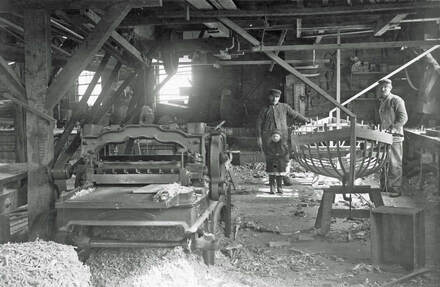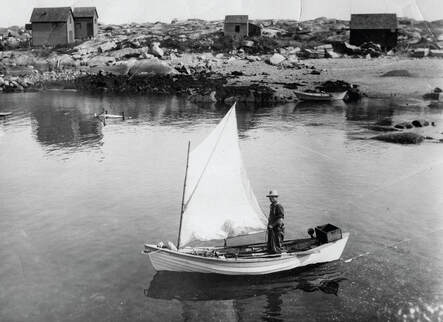PEAPOD
The earliest peapods were derived from seagoing canoes used by the Passamaquoddy Indians and were built using birch bark for sheathing. Soon, the boats were adapted to a plank-on-frame construction and equipped with oars and sail. Fish Commission investigators working in Maine in the early 1880s were informed that the plank on frame peapod originated at North Haven, around 1870. Peapods, along with dories, were the sturdy working boats of nearly all island residents who used them for local travel and fishing. Later, they were adapted for lobstering at a time when traps were hauled by hand.
From the mid 19th century through the early days of the 20th century, nearly everyone on North Haven depended on a good rowing boat to get from one area of the island to another. Roads were rough and at times impassable, thus ownership of a peapod (or similar boat) was a necessity.
The original peapods were built with some heft to them, weighing over 300 lbs. This weight helped settle the boat in rough waves and kept it steady. Peapods are either lapstrake construction or carvel planked. Our peapod is lapstrake. Peapods could also be rigged with sprit sails; when this was done they were built with a deeper keel. Before outboard motors were common, peapods were often rowed off shore in the morning and sailed back home after a day’s work. If you were caught in rough weather, a peapod would almost always get you home safely.
This peapod is a beautiful example of its type, made with 1⁄4 inch cedar planking, copperfastened to apple and oak ribs. It was, most likely, built by Fred Brown whose specialty was pea-pods. Brown had a sizeable boatyard down near Deacon Brown’s Point where his shop included an early steam engine to power a big band saw and other boatbuilding equipment. Brown built this peapod for Arthur Martell, a summer resident of Bartlett’s Harbor. It was always intended as a recreational boat and is considerably lighter than working peapods.
Fred Allen and his family acquired the boat in 1933 from Martell. Allen and his friends found this peapod especially appealing because it is light enough to portage easily. Allen remembers that with its light, smooth lines and sharp double ends, “it was easily the fastest rowing boat in the harbor, especially with two oarsmen.”
From the mid 19th century through the early days of the 20th century, nearly everyone on North Haven depended on a good rowing boat to get from one area of the island to another. Roads were rough and at times impassable, thus ownership of a peapod (or similar boat) was a necessity.
The original peapods were built with some heft to them, weighing over 300 lbs. This weight helped settle the boat in rough waves and kept it steady. Peapods are either lapstrake construction or carvel planked. Our peapod is lapstrake. Peapods could also be rigged with sprit sails; when this was done they were built with a deeper keel. Before outboard motors were common, peapods were often rowed off shore in the morning and sailed back home after a day’s work. If you were caught in rough weather, a peapod would almost always get you home safely.
This peapod is a beautiful example of its type, made with 1⁄4 inch cedar planking, copperfastened to apple and oak ribs. It was, most likely, built by Fred Brown whose specialty was pea-pods. Brown had a sizeable boatyard down near Deacon Brown’s Point where his shop included an early steam engine to power a big band saw and other boatbuilding equipment. Brown built this peapod for Arthur Martell, a summer resident of Bartlett’s Harbor. It was always intended as a recreational boat and is considerably lighter than working peapods.
Fred Allen and his family acquired the boat in 1933 from Martell. Allen and his friends found this peapod especially appealing because it is light enough to portage easily. Allen remembers that with its light, smooth lines and sharp double ends, “it was easily the fastest rowing boat in the harbor, especially with two oarsmen.”

